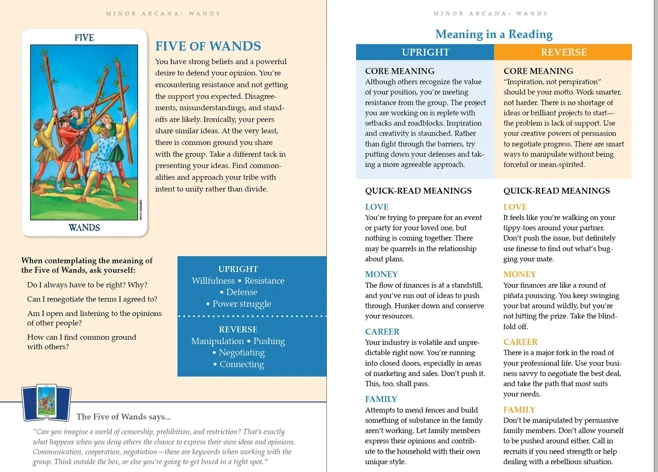The world of tarot decks is a kaleidoscope of themes and artistic styles, each offering a unique journey into the realm of divination. Whether you are a seasoned tarot reader or a curious beginner, exploring the multitude of deck options can be both exciting and overwhelming. In this article, we will delve into the fascinating realm of tarot deck themes and explore the diverse artistic styles that bring these decks to life. From traditional to contemporary, classic to abstract, and everything in between, we will unravel the influence of artistic styles on tarot interpretation. Join us on this enchanting voyage as we uncover popular tarot deck themes, their corresponding art styles, and even provide insights into creating your very own tarot deck. Get ready to unlock the mysteries of tarot cards and ignite your imagination in a world where artistry and divination intertwine.
Contents
- Understanding Tarot Deck Themes
- Exploring Tarot Artistic Styles
- Influence of Artistic Styles on Tarot Interpretation
- Popular Tarot Deck Themes and Their Art Styles
- Creating Your Own Tarot Deck
- Conclusion
-
Frequently Asked Questions
- 1. Can I use any tarot deck for readings, regardless of the theme?
- 2. How do I know which tarot deck theme is right for me?
- 3. Are tarot deck themes purely decorative, or do they influence the reading?
- 4. Are there specific tarot deck themes that are better for beginners?
- 5. Can I mix and match tarot decks with different themes in one reading?
- 6. Are there tarot deck themes specifically designed for certain types of questions or situations?
- 7. Can the artwork in tarot decks affect the accuracy of the readings?
- 8. Are there tarot deck themes that are better suited for certain types of personalities?
- 9. Can tarot deck themes change over time?
- 10. Is it possible to create my own tarot deck with a personalized theme?
- References
Understanding Tarot Deck Themes
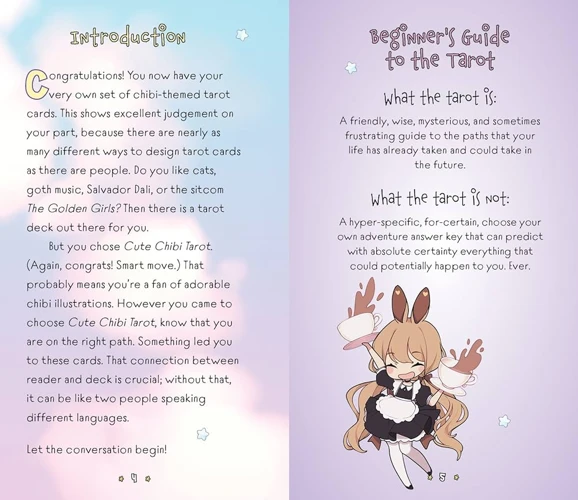
Understanding Tarot Deck Themes is crucial for both experienced tarot readers and beginners alike. Tarot decks come in a variety of themes that cater to different interests, spiritual beliefs, and aesthetic preferences. Traditional Tarot Themes encompass the iconic Rider-Waite deck and its variations, such as the Visconti-Sforza and Marseille decks. These decks follow the traditional tarot structure and symbolism, making them a popular choice for those seeking a more classic and foundational experience. On the other hand, Contemporary Tarot Themes offer a fresh take on the traditional tarot with modern interpretations and imagery. These decks often include themes like nature, animals, or pop culture references, appealing to a younger generation of tarot enthusiasts. Lastly, we have Unique Tarot Deck Themes that delve into specific areas of interest, such as astrology, mythology, fairy tales, or even cats. These decks provide a niche experience and can be a great option for individuals looking to explore tarot through a specific lens. By understanding the different themes available, readers can choose a deck that resonates with their personal interests and beliefs, enhancing their connection and interpretation of the cards. For a deeper understanding of the importance of tarot deck connection, please visit our article on Tarot Deck Connection and Its Importance. Additionally, if you’re unsure how to choose the right tarot deck for yourself, check out our guide on How to Choose the Right Tarot Deck for helpful tips and insights.
1. Traditional Tarot Themes
Traditional Tarot Themes encompass the rich history and symbolism of the tarot tradition. These decks hold a sense of nostalgia and cultural significance, making them a popular choice for tarot enthusiasts. One of the most well-known and influential decks in this category is the Rider-Waite Tarot. Illustrated by Pamela Colman Smith under the guidance of renowned mystic Arthur Edward Waite, this deck features iconic imagery that has become the standard for many modern tarot decks. The Major Arcana cards in the Rider-Waite deck depict archetypal figures and scenes, while the Minor Arcana cards showcase vivid, intricate illustrations that represent the four elements and different aspects of life. Another traditional tarot deck is the Visconti-Sforza Tarot, an exquisite deck originating from 15th century Italy. This deck features beautiful hand-painted cards that are rich in symbolism and historical importance. Similarly, the Marseille Tarot, another traditional deck, has its roots in 18th century France. Known for its bold and simplified artwork, the Marseille Tarot focuses on the essence of each card’s meaning. Traditional tarot themes often evoke a sense of spirituality and mysticism, providing a deeper connection to the cards and allowing for profound introspection. To explore the spiritual aspects of tarot decks, please visit our article on Tarot Deck Spirituality.
2. Contemporary Tarot Themes
Contemporary Tarot Themes offer a refreshing twist on traditional tarot decks, catering to modern sensibilities and diverse interests. These decks bring a contemporary flair to the world of tarot, incorporating elements that resonate with a younger generation of tarot enthusiasts. Let’s explore some popular contemporary tarot themes:
1. Nature and Animals: Tarot decks themed around nature and animals connect us with the natural world and its inherent wisdom. These decks often feature vibrant artwork depicting flora, fauna, and animal symbolism. They remind us of our connection to the earth and invite us to tap into our intuition through the wisdom of nature.
2. Pop Culture: For those who enjoy the intersection of tarot and modern popular culture, there are decks themed around movies, TV shows, music, and even video games. These decks incorporate characters, symbols, and references from beloved pop culture icons, making the tarot reading experience both fun and relatable.
3. Spirituality and Self-Discovery: Contemporary tarot decks focused on spirituality and self-discovery delve into themes such as mindfulness, personal growth, and inner reflection. They often incorporate affirmations, inspirational quotes, and prompts for self-reflection, providing a tool for personal development and spiritual exploration.
4. Minimalistic and Modern: Minimalistic tarot decks appeal to those who appreciate clean lines, simplicity, and a modern aesthetic. These decks often feature minimalist artwork with stripped-down symbolism, allowing for a more open-ended and intuitive interpretation of the cards.
5. Social Justice and Diversity: In recent years, there has been a rise in tarot decks that address social justice issues, celebrate diversity, and promote inclusivity. These decks amplify marginalized voices, offering a platform for representation and highlighting important social and cultural themes.
Contemporary tarot themes allow for a wide range of artistic expression and storytelling, reflecting the ever-evolving landscape of our society. They cater to individual preferences and interests, making tarot accessible and relevant to a diverse audience. Whether you resonate with nature, pop culture, spirituality, minimalism, or social justice, there is a contemporary tarot deck out there that speaks to you and invites you to explore the tarot’s wisdom through a fresh and modern lens.
3. Unique Tarot Deck Themes
When it comes to unique tarot deck themes, the possibilities are endlessly fascinating. These decks offer a departure from the traditional tarot structure and explore various niche interests and concepts. Here are a few examples of captivating and distinctive tarot deck themes:
Astrology: Astrology-themed tarot decks combine the wisdom of the stars with the symbolism of tarot cards. Each card represents a zodiac sign, planet, or astrological concept, providing a powerful tool for astrology enthusiasts to delve deeper into their practice.
Mythology: Mythology-inspired tarot decks draw upon ancient tales and legends from different cultures. These decks often feature gods, goddesses, mythical creatures, and symbols from mythological stories, allowing users to connect with archetypal energies and explore universal themes.
Fairy Tales: Tarot decks based on fairy tales bring a touch of magic and whimsy to divination. Each card depicts scenes and characters from beloved fairy tales, infusing tarot readings with an enchanting and imaginative narrative.
Animal Spirit Guides: Animal-themed tarot decks tap into the wisdom and symbolism of various animals. Each card represents a different animal spirit guide, offering insights and guidance based on their unique qualities and characteristics.
Cultural Legends: Tarot decks inspired by specific cultures, such as Celtic, African, or Native American, incorporate cultural symbols, folklore, and indigenous wisdom. These decks provide a rich tapestry of ancestral knowledge and spirituality for users to explore.
Whether you have a particular interest in astrology, mythology, fairy tales, animal symbolism, or cultural legends, a unique tarot deck theme can enhance your tarot practice and resonate deeply with your personal journey. Embrace the magic and diversity of tarot as you embark on a quest through these remarkable and extraordinary tarot deck themes.
Exploring Tarot Artistic Styles
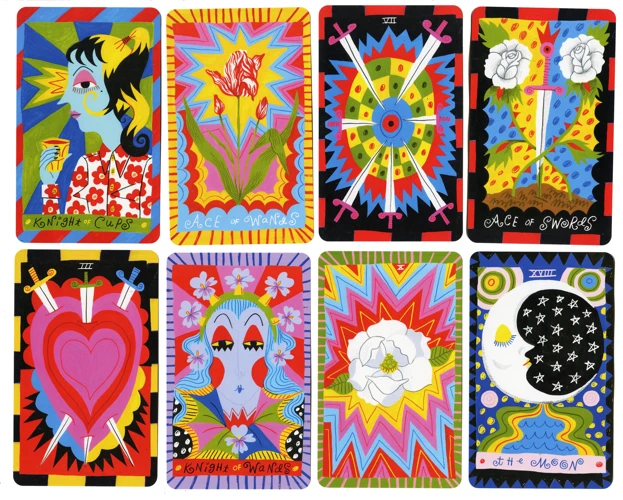
Exploring Tarot Artistic Styles adds a fascinating layer to the tarot experience, as each artistic style brings its own unique energy and interpretation to the cards. There are several distinct styles that tarot artists employ to breathe life into their decks.
1. Classic Artistic Styles: These styles draw inspiration from traditional art forms and historical periods. They often feature detailed illustrations, intricate borders, and rich symbolism. The classic artistic style can be seen in decks like the Rider-Waite Tarot, where the artwork is reminiscent of medieval and Renaissance paintings.
2. Modern and Abstract Art Styles: In contrast to the classic style, modern and abstract art styles offer a fresh and contemporary approach to tarot deck design. These decks embrace bold colors, geometric shapes, and abstract imagery, creating a visually striking and thought-provoking experience. The Tarot of the Silicon Dawn is an excellent example of a deck that embodies the modern and abstract art style, with its vibrant and futuristic illustrations.
3. Illustrative and Fantasy Art Styles: Illustrative and fantasy art styles transport us into magical realms where imagination knows no bounds. These decks often feature fantastical creatures, enchanting landscapes, and intricate details that spark the imagination. The Shadowscapes Tarot is renowned for its mesmerizing fantasy art style, immersing the reader in a dreamlike world of myth and magic.
Whether you resonate with the classic, modern, or fantasy art styles, each has its own allure and impact on tarot interpretation. The choice of art style ultimately depends on personal preference and the energy you wish to embody during your tarot readings. So, take your time to explore and appreciate the diverse artistic styles available, and allow your intuition to guide you towards the deck that speaks to your soul.
1. Classic Artistic Styles
Classic Artistic Styles in tarot decks evoke a sense of nostalgia and tradition. These styles often draw inspiration from art movements of the past, such as Renaissance, Baroque, or Romanticism. One example of a tarot deck featuring a classic artistic style is the Rider-Waite Tarot. Illustrated by Pamela Colman Smith, this iconic deck showcases intricate line work and rich colors, reminiscent of early 20th-century art. The cards feature symbolic imagery, with each card meticulously designed to convey its unique meaning. Another classic artistic style can be found in the Visconti-Sforza Tarot, believed to be one of the oldest surviving tarot decks. This deck’s artistic style reflects the aesthetics of the Italian Renaissance, with its delicate and detailed illustrations. Classic artistic styles in tarot decks not only pay homage to the historical origins of tarot, but they also serve as a visual representation of the archetypal meanings embedded within the cards. These timeless styles create a connection to the past and add a layer of depth to the tarot reading experience.
2. Modern and Abstract Art Styles
Modern and abstract art styles in tarot decks bring a contemporary and innovative approach to the traditional symbolism of the cards. These decks push the boundaries of conventional imagery, offering a fresh perspective on tarot interpretation. In modern art styles, bold colors, geometric shapes, and minimalist designs take center stage. Artists may use abstract representations to convey the essence of each card, allowing for personal interpretation and reflection. The use of clean lines and simplified forms in modern art decks creates a visually striking aesthetic that appeals to individuals who appreciate a sleek and sophisticated look. Abstract art styles, on the other hand, embrace non-representational forms and experimental techniques. These decks may feature surreal or dreamlike imagery, exploring the realms of the subconscious mind and allowing for intuitive exploration. The abstract nature of these decks encourages readers to tap into their own intuition and emotions for a deeper understanding of the cards. Both modern and abstract art styles in tarot decks provide a departure from traditional imagery, inviting readers to engage with the cards in a fresh and thought-provoking way. The use of these artistic styles allows for a broader range of interpretations and encourages individual exploration and personal connection with the cards.
3. Illustrative and Fantasy Art Styles
Illustrative and Fantasy Art Styles in tarot decks offer a visually captivating and imaginative experience. These art styles often feature intricate illustrations, vibrant colors, and fantastical elements that transport the reader into a whimsical world. In Illustrative Art Styles, each card is a work of art, telling a story through detailed and symbolic imagery. The illustrations may incorporate themes such as mythology, nature, or sacred geometry, adding depth and meaning to the tarot reading. This style allows the reader to dive into the imagery and unravel the layers of symbolism within the cards. On the other hand, Fantasy Art Styles take the reader on a journey through realms of magic and enchantment. These decks often feature mythical creatures, mystical landscapes, and ethereal beings. The fantastical elements in these decks invite the readers to tap into their imagination and explore the realms of possibilities. The vivid colors and whimsical illustrations within this style evoke emotional responses and spark the reader’s intuition. Whether it’s a deck inspired by fairy tales, dragons, or other mythical realms, the fantasy art style adds a touch of mysticism and wonder to the tarot reading experience. Tarot decks with illustrative and fantasy art styles are perfect for those who seek inspiration, creativity, and a touch of magic in their tarot readings. The visual richness and storytelling within these decks can enhance the connection between the reader, the cards, and the messages being conveyed.
Influence of Artistic Styles on Tarot Interpretation
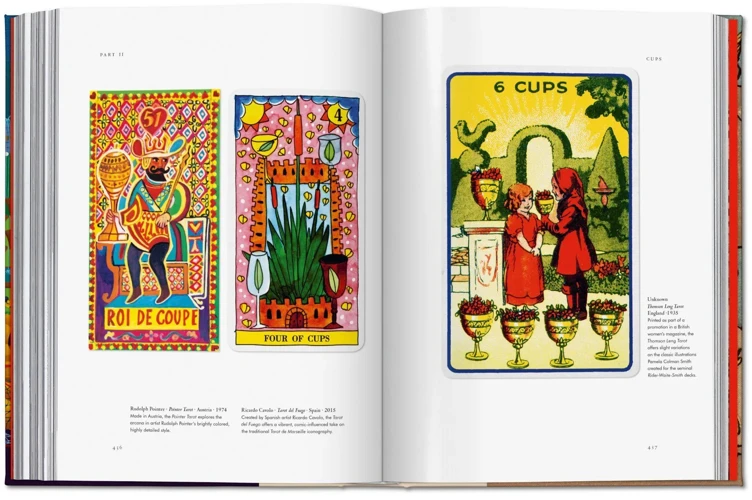
The artistic style of a tarot deck plays a significant role in the interpretation of the cards. The choice of Classic Artistic Styles such as Renaissance or Baroque can evoke a sense of tradition and evoke the historical roots of tarot symbolism. The detailed and realistic images in these decks allow for a deep exploration of the cards’ meanings. On the other hand, Modern and Abstract Art Styles offer a fresh and contemporary approach to tarot interpretation. These decks utilize bold colors, geometric shapes, and abstract imagery to provoke new perspectives and intuitive insights. They encourage readers to tap into their own creativity and interpret the cards in a more fluid and personal manner. Illustrative and Fantasy Art Styles encompass decks that portray whimsical and fantastical elements. These decks often feature mythical creatures, magical landscapes, and intricate details that invite readers into a world of imagination and unlimited possibilities. The art style can influence how we connect with the cards, stirring different emotions and resonating with different aspects of our subconscious. Ultimately, the choice of artistic style allows for a customized reading experience, shaping the way we interpret the messages and symbols presented in the tarot.
Popular Tarot Deck Themes and Their Art Styles
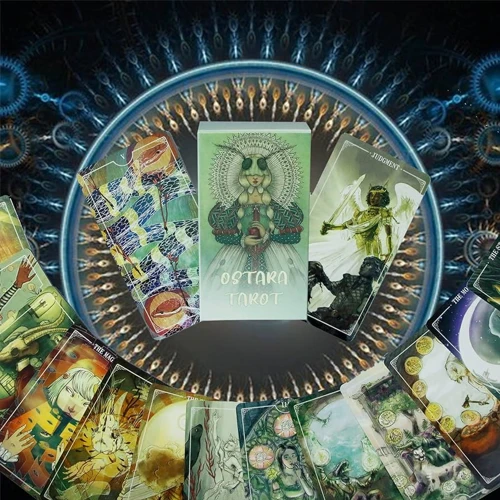
Popular Tarot Deck Themes and Their Art Styles offer a diverse range of options for tarot enthusiasts. One such example is the Rider-Waite Tarot, which features classic art style. This timeless deck, with its detailed illustrations by Pamela Colman Smith, has become the standard for tarot readings. The deck’s art style incorporates vibrant colors and intricate symbolism, allowing readers to interpret the cards with clarity and depth. Another popular deck, the World Spirit Tarot, showcases an abstract art style. Created by Lauren O’Leary and Jessica Sczuka Godino, this deck takes a unique approach by blending spiritual and cultural themes with abstract, flowing designs. The art style encourages readers to tap into their intuition and explore the esoteric aspects of the tarot. Lastly, we have the Shadowscapes Tarot, which boasts a fantasy art style. Illustrated by Stephanie Pui-Mun Law, this enchanting deck transports readers to a mystical realm filled with ethereal landscapes and magical beings. The fantasy art style enhances the deck’s otherworldly aura, making it a favorite for those seeking a whimsical and enchanting tarot experience. Each of these popular tarot deck themes, along with their corresponding art styles, provides a unique visual and interpretive journey for readers. Whether you resonate with the classic, abstract, or fantasy art styles, there is a deck out there that will speak to your spirit and guide you in your tarot explorations.
1. Rider-Waite Tarot with Classic Art Style
The Rider-Waite Tarot deck, with its classic art style, holds a prominent position in the world of tarot. This iconic deck, first published in 1910, features timeless illustrations by Pamela Colman Smith. The classic art style of the Rider-Waite deck embodies rich symbolism and archetypal imagery, making it a popular choice for both beginners and experienced readers. The intricate details, vibrant colors, and meticulous attention to symbolism in each card allow for deep exploration and interpretation. The Major Arcana cards, such as The Fool and The Empress, beautifully depict the journey of the human experience, while the Minor Arcana cards represent different aspects of daily life. The classic art style of the Rider-Waite Tarot deck transcends time, providing readers with a visually captivating and evocative experience. Whether you’re studying the cards individually or conducting spreads, the classic art style of the Rider-Waite Tarot deck offers a solid foundation for learning tarot and developing your intuitive abilities.
2. World Spirit Tarot with Abstract Art Style
The World Spirit Tarot is a captivating deck that embraces an abstract art style. Created by artist Lauren O’Leary and collaborator Jessica Godino, this deck offers a unique and ethereal interpretation of the tarot. The abstract art style of the World Spirit Tarot takes a departure from traditional imagery and instead invites the reader into a world of vibrant colors, flowing shapes, and dreamlike symbolism. Each card in this deck is a visual masterpiece, with its own story to tell and its own energy to convey. The abstract art style allows for a more intuitive and personal interpretation of the cards, as it encourages the reader to tap into their subconscious and connect with the deeper meanings hidden within the artwork. The use of bold and dynamic shapes, along with the fusion of various colors and textures, creates a visually stimulating experience that can ignite the imagination and evoke powerful emotions. Whether you are a seasoned tarot enthusiast or a newcomer to the world of divination, the World Spirit Tarot with its abstract art style offers a captivating and evocative journey into the realm of tarot symbolism and intuition.
3. Shadowscapes Tarot with Fantasy Art Style
The Shadowscapes Tarot deck is a stunning example of the Fantasy Art Style within the realm of tarot cards. Created by Stephanie Pui-Mun Law, this deck transports its users into a whimsical, ethereal world filled with fantastical creatures, enchanting landscapes, and intricate details. The artwork of the Shadowscapes Tarot is characterized by its vivid colors, delicate lines, and dreamlike imagery, making it a favorite among lovers of fantasy and magic.
Each card in the Shadowscapes Tarot deck is meticulously designed to evoke a sense of wonder and mystery. The Major Arcana cards showcase powerful mythical creatures like dragons, unicorns, and mermaids, while the Minor Arcana cards feature ethereal beings and nature spirits. The use of symbolism and storytelling within the artwork adds layers of depth and meaning to each card, allowing for a rich and immersive tarot reading experience.
The Fantasy Art Style of the Shadowscapes Tarot deck not only captivates the eyes but also stimulates the imagination. The enchanting visuals invite users to explore their own subconscious and connect with the archetypal energy represented by each card. Whether you are an experienced reader or a beginner, the Shadowscapes Tarot deck offers a unique and magical journey that can unlock new insights and perspectives.
With its intricate illustrations and mystical ambiance, the Shadowscapes Tarot deck is a testament to the power of art to evoke emotion and inspire introspection. Whether used for personal reflection, divination, or creative inspiration, this deck demonstrates how the Fantasy Art Style can breathe life into the traditional tarot system and create a truly enchanting experience.
Creating Your Own Tarot Deck
Creating Your Own Tarot Deck is an exciting and personal endeavor that allows you to express your unique vision and connect with the cards on a deeper level. Here are two essential steps to guide you in this creative process.
1. Selecting a Theme: Choosing a theme for your tarot deck sets the tone and influences the overall symbolism and imagery of the cards. Think about your interests, passions, or spiritual beliefs that you want to explore through the deck. It could be anything from nature and animals to mythology or even a personal narrative. Selecting a theme that resonates with you will ensure a more meaningful and cohesive deck.
2. Choosing an Artistic Style: The artistic style you choose plays a crucial role in bringing your tarot deck to life and evoking the desired emotional response. Consider the various art styles available, such as realistic, abstract, or illustrative, and how they align with your chosen theme. Research different artists or illustrators who specialize in your preferred style and explore their portfolios for inspiration.
Once you have a clear theme and artistic style in mind, you can start creating your own tarot deck. Begin by sketching out the designs for each card, focusing on capturing the essence of the theme and incorporating relevant symbolism. Don’t be afraid to experiment and iterate as you refine your artwork.
To maintain consistency and coherence throughout the deck, consider the card layout, color palette, and typography. These elements contribute to the overall presentation and readability of the cards.
As you progress, seek feedback from other tarot enthusiasts or artists to gain valuable insights and refine your deck further. Embrace the creative process and trust your intuition as you bring your vision to life.
By creating your own tarot deck, you not only infuse it with your personal energy and intentions but also deepen your connection to the cards. It becomes a powerful tool for self-reflection, intuition, and divination. So, let your creativity soar, and embark on this rewarding journey of crafting a tarot deck that is uniquely yours.
1. Selecting a Theme
When it comes to creating your own tarot deck, selecting a theme is a crucial first step in the process. allows you to infuse your deck with personal meaning and intention, making it a unique and authentic representation of your inner world. To choose the right theme, start by considering your interests, passions, and areas of expertise. Are you drawn to nature, mythology, or a specific spiritual practice? Make a list of themes that resonate with you and explore their potential symbolism and imagery in relation to the tarot. Another approach is to consider the purpose of your deck. Will it be used for self-reflection, spiritual guidance, or creative inspiration? This can help narrow down themes that align with your deck’s intended use. Additionally, think about your target audience. Are you creating a deck for beginners, experienced readers, or a specific community? Understanding your audience can inform the theme selection process. Once you have a few theme options in mind, spend time researching existing tarot decks with similar themes to gain inspiration and gather ideas. Remember, the theme you choose should be one that resonates deeply with you and sparks your creativity throughout the deck creation process.
2. Choosing an Artistic Style
When it comes to selecting an artistic style for your tarot deck, there are endless possibilities to consider. Choosing an Artistic Style is essential as it plays a significant role in how the tarot cards visually communicate their meanings. One popular option is the Classic Artistic Style, which draws inspiration from renowned artists like Leonardo da Vinci or Michelangelo. These decks often feature detailed and realistic illustrations that evoke a sense of timelessness and sophistication. On the other end of the spectrum, we have the Modern and Abstract Art Styles. These decks utilize bold colors, geometric shapes, and abstract imagery to convey the essence of the tarot symbolism in a contemporary way. They offer a visually stimulating experience that invites interpretation and personal reflection. Another captivating choice is the Illustrative and Fantasy Art Styles. These decks bring whimsical, magical, and fantastical elements to the tarot cards. They transport us to other worlds and realms, capturing our imagination and inviting us on a mystical journey. When choosing an artistic style, it’s important to consider your personal preferences and the emotions and impressions different art styles evoke in you. Ultimately, finding a style that resonates with you will enhance your connection to the tarot deck and deepen your understanding of the cards’ messages. Let your intuition guide you as you explore the vast array of artistic styles available and choose the one that speaks to your soul.
Conclusion
In conclusion, exploring tarot deck themes and artistic styles is an enchanting journey that allows individuals to connect with the tarot cards on a deeper level. The wide range of themes, from traditional to contemporary to unique, offers something for everyone, catering to diverse interests and spiritual beliefs. Likewise, the various artistic styles, whether classic, modern, abstract, or fantasy, contribute to the overall interpretation and aesthetic appeal of the tarot deck. It is important to understand the influence of these artistic styles on tarot interpretation, as they can evoke different emotions and perspectives when working with the cards. By exploring popular tarot deck themes and their corresponding art styles, such as the classic Rider-Waite Tarot, the abstract World Spirit Tarot, and the fantasy-inspired Shadowscapes Tarot, individuals can gain inspiration and insight into their own tarot practice. And for those feeling inspired to create their own tarot deck, careful consideration should be given to selecting a theme that resonates and choosing an artistic style that complements the intended interpretation. Ultimately, the world of tarot decks offers endless possibilities for exploration and personal growth, opening the door to a wondrous realm of symbolism and divination.
Frequently Asked Questions
1. Can I use any tarot deck for readings, regardless of the theme?
Yes, you can use any tarot deck for readings, regardless of the theme. The theme of the deck mainly affects the artwork and symbolism used in the cards, but the core meanings and interpretations of the tarot remain the same.
2. How do I know which tarot deck theme is right for me?
Choosing the right tarot deck theme depends on your personal interests, spiritual beliefs, and the aesthetic that resonates with you. Explore different themes, read reviews, and trust your intuition to find a deck that feels aligned with your energy.
3. Are tarot deck themes purely decorative, or do they influence the reading?
Tarot deck themes go beyond pure decoration. The artwork and symbolism of the cards can evoke specific emotions, resonate with personal experiences, and enhance the storytelling aspect of the reading. The theme can add layers of meaning and context to the interpretations.
4. Are there specific tarot deck themes that are better for beginners?
There isn’t a specific tarot deck theme that is inherently better for beginners. It ultimately depends on your individual preferences and connection with the imagery. Some beginners may find traditional themes easier to grasp, while others may resonate more with contemporary or unique themes.
5. Can I mix and match tarot decks with different themes in one reading?
Yes, you can mix and match tarot decks with different themes in one reading. Some readers believe that combining decks can offer a broader perspective and deeper insights. However, it’s important to find a harmonious balance between the decks to maintain cohesiveness in the reading.
6. Are there tarot deck themes specifically designed for certain types of questions or situations?
While there are no tarot deck themes specifically designed for certain types of questions or situations, certain themes may resonate more strongly with specific topics. For example, decks with a spiritual or mystical theme may be well-suited for questions regarding spirituality or personal growth.
7. Can the artwork in tarot decks affect the accuracy of the readings?
The artwork in tarot decks does not directly affect the accuracy of the readings. The accuracy primarily depends on the reader’s interpretation and intuition. However, the artwork can inspire the reader and the querent, creating a more engaging and meaningful reading experience.
8. Are there tarot deck themes that are better suited for certain types of personalities?
While there are no tarot deck themes that are universally better suited for certain types of personalities, some individuals may resonate more with specific themes based on their interests or preferences. It’s important to choose a deck that aligns with your own unique personality and resonates with you on a deeper level.
9. Can tarot deck themes change over time?
Yes, tarot deck themes can change over time as new decks are created and new artistic styles emerge. Tarot reflects the ever-evolving world, and themes can evolve to cater to the interests and demands of modern readers.
10. Is it possible to create my own tarot deck with a personalized theme?
Absolutely! Many tarot enthusiasts have created their own personalized tarot decks with themes that are meaningful to them. From selecting the artwork to designing the symbolism, creating your own tarot deck can be a fulfilling and creative endeavor.
